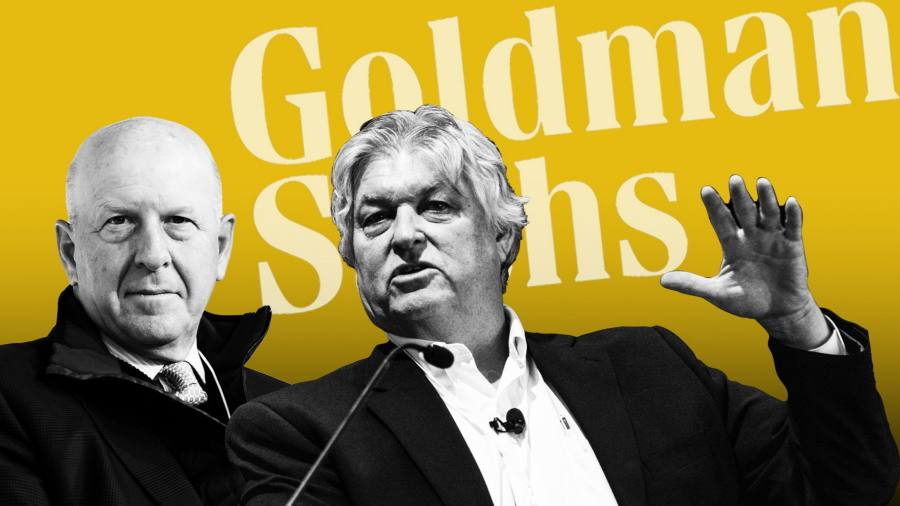After Tom Montag fell behind in the race to lead Goldman Sachs in 2006, he lost no time in forging a new path at a Wall Street rival. Now he is on track to return to the bank at a time when it is lagging behind some of its peers.
The planned appointment, announced by Goldman on Thursday, has been in the works for a while. Montag, 66, started talks with the bank about a year ago, according to one person familiar with the matter, as Goldman looked for a replacement for Mark Winkelman, another former senior Goldman executive who retired from the board this year.
Ending up in a Wall Street boardroom is a familiar coda for an industry grandee like Montag. He spent 22 years at Goldman and then worked as second-in-command at Bank of America in a productive 13-year run, which ended in 2021 following news reports that raised questions over the culture he fostered.
His return comes amid heightened focus on Goldman’s supposed malaise, with the group’s stock performance trailing rivals and chief executive David Solomon facing a constant barrage of negative media coverage.
The appointment has been big news this week at Goldman’s 200 West headquarters in lower Manhattan and has also sparked debate among the bank’s alumni network, whose members include prime ministers, chief executives and billionaire investors.
One side expects Montag to be a booster on the board for Solomon, 61, in what is a part-time job. Others see him as a member of the old guard who will add much-needed trading experience to the boardroom and will not be afraid to point out any issues at Goldman.
“He has no problem speaking his mind. But he’s not running the firm, he’s sitting on the board,” said one former Goldman executive who has worked with both Montag and Solomon.
The Financial Times spoke to a dozen former colleagues of Montag at Goldman and BofA. He won praise for his keen eye for detail and exacting leadership style that could engender deep loyalty. But some who went up against him depicted a combative figure, with several former colleagues describing him as a “bully”.
Montag did not respond to requests for comment.
“The priority is to always have strong risk management experience on the board,” said Goldman spokesperson Tony Fratto. “It’s rare to find candidates with senior experience at large, complex, global financial institutions who are available to serve as independent directors.”
A physically imposing, hard-charging Wall Street figure, Montag — or Monty as he is known to friends — joined Goldman in 1985 when it was still a tight-knit privately held firm controlled by its elite group of partners.
An economics graduate from Stanford University, he worked as a derivatives trader and made partner in 1994. He burnished his credentials when he helped lead the group’s Japanese operations and co-ran Goldman’s Asian trading franchise.
“He was amazing at running the Asia business,” recalled one former colleague.
Beth Hammack, a co-head of the global financing group at Goldman who worked with Montag for several years, described him as “one of the most inspirational leaders that I’ve worked with”.
“He’s really charismatic and energetic, really knows how to support a business and people, and how to make them feel engaged, paid attention to and get the best out of them,” Hammack told the FT.
Montag rose to be global co-head of sales and trading but left Goldman at the end of 2007 after losing out to Gary Cohn and Jon Winkelried in a promotion race to become co-president of the group under Lloyd Blankfein.
In 2010, Montag made a reappearance of sorts for Goldman at congressional hearings in the aftermath of the financial crisis, when lawmakers seized on a June 2007 email he sent that referred to Timberwolf, a $1bn mortgage-related deal Goldman worked on, as “shitty”.
“How much of that shitty deal did you sell to your clients after June 22 2007?” then-senator Carl Levin asked another former Goldman executive, Daniel Sparks, in 2010. Sparks said Montag was referring to Goldman’s performance on Timberwolf, not the deal itself.
Solomon, meanwhile, joined Goldman in 1999 from Bear Stearns. The two men were both partners in what was then Goldman’s fixed income division, although Solomon was a leverage finance banker while Montag worked as a trader and they were not particularly close, according to people who were there at the time.
Montag joined Merrill in 2008 where he went to work for John Thain, another Goldman alum, after being lured by a $39mn pay package. Within months of his arrival, Merrill agreed to be taken over by BofA in a rushed merger to save the investment bank.
Montag was crucial in integrating Merrill into BofA and steadily grew his portfolio of responsibilities, rising to be chief operating officer and president of global banking and markets. He also bolstered the bank’s diversity programmes, pushing to recruit from a broader range of schools and spearheading a recruitment effort in Africa.
“Tom Montag did a great job at Bank of America during one of the most challenging periods in financial services history,” BofA said in a statement this week.
He left the bank in 2021 after 13 years, a few months after a New York Times report alleged that Montag was a polarising figure inside BofA, played favourites with some staff and patronised certain female employees.
Montag became chief executive last year of California-based Rubicon Carbon, a carbon offset software platform backed by private investment group TPG. With a board seat at Goldman, he will be back at Wall Street’s coalface.
But he will return to a group that is markedly different from the one he left 15 years ago. Goldman was turned into a bank holding company during the 2008 financial crisis and has been adjusting to life as a much more heavily regulated organisation that can no longer rely on the risky trades of its heyday.
For a time it looked like Goldman’s next big bet would be a push into consumer banking. But following billions of dollars in losses, Goldman is now in the process of scaling back that business.
Solomon, who took over from Blankfein in 2018, is emphasising growth plans in asset and wealth management to deliver the sort of steady profits that have boosted longtime rival Morgan Stanley’s share price.
But morale has been hit by lay-offs at the start of the year and disgruntlement among traders over what they were paid for a record performance in 2022. With investment banking still in the doldrums and a trading boom beginning to fade, there are worries that the rest of the year will be challenging.
Several Goldman executives say privately that 2023 is shaping up to be another disappointing year for remuneration. More lay-offs could come in September, with Goldman also considering cutting staff it deems to be underperforming, a process that resumed last year after a pause during the coronavirus pandemic.
When Goldman reports second-quarter earnings on July 19, analysts expect earnings per share to have declined by about 8 per cent from a year earlier, according to consensus data compiled by Bloomberg. Rivals JPMorgan Chase and Morgan Stanley, which are less reliant on trading and investment banking, are expected to deliver improved EPS.
Montag’s return sparked some Wall Street speculation that he might still fancy a chance to run his old bank.
“I bet you in the back of his mind he thinks he can be CEO of Goldman Sachs,” said one person who used to work with Montag at Goldman. “I bet he does.”
Read the full article here




